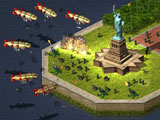 How do you
kick a little life into an aging franchise, especially when that franchise belongs to the
most overworked genre around, must compete with monstrously popular games like Age of
Empires and Starcraft, and when said franchise's last installment, the much-awaited and
uber-earnest Tiberian Sun, was seen by most critics and players as OK at best? What can you do to make sure that a sequel to Red
Alert, one of the only titles most gamers unhesitatingly refer to as “beloved”,
doesn’t tank ingloriously? Well, if you’re Westwood, you can produce Command and
Conquer: Red Alert 2, the game that’s not so much a sequel to as a parody of Red
Alert. And I mean that in the best possible way. How do you
kick a little life into an aging franchise, especially when that franchise belongs to the
most overworked genre around, must compete with monstrously popular games like Age of
Empires and Starcraft, and when said franchise's last installment, the much-awaited and
uber-earnest Tiberian Sun, was seen by most critics and players as OK at best? What can you do to make sure that a sequel to Red
Alert, one of the only titles most gamers unhesitatingly refer to as “beloved”,
doesn’t tank ingloriously? Well, if you’re Westwood, you can produce Command and
Conquer: Red Alert 2, the game that’s not so much a sequel to as a parody of Red
Alert. And I mean that in the best possible way.
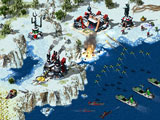 With perhaps the exception Grim Fandango,
I’ve never seen a game knowingly make fun of itself quite so much as Red Alert 2.
First of all, the game builds on Red Alert’s implausible story (if you’re not in
the know, Red Alert begins with Einstein inventing a time machine, going back to 1939, and
assassinating Hitler—this predicates a war between Russia and the USA). Red Alert 2
is, if anything, even goofier. Though Red Alert ends with the USA and its allies defeating
the Soviets and installing a Romanov (now there’s good thinking) as premier, it seems
this scheme for keeping the Russian down isn’t nearly as effective as introducing
market capitalism and organized crime. Thus
the Soviet Union soon rebuilds its military, and, with the help of a typically creepy
scientist named Yuri, invents a psychic beacon that takes over people’s minds. This
allows the reconstituted USSR to launch a surprise attack on the land of the free, and
soon such cities as New York, Chicago, and Saint Louis become battlegrounds. Of course
this is all impossibly dumb, like a combination of the pinhead cult favorite movie Red
Dawn and all those paranoid Red Scare mind-control flicks from the 50’s, but it
works; the game’s got enough tongue-in-cheek to be stoopid like a Ramones tune rather
than stupid like something from Britney Spears. There’s a slyness to the game’s
setting and story that shows up at unlikely moments; for instance, in one mission
you’ll have to infiltrate the Soviet stronghold of St. Louis and destroy a psychic
beacon, which is located in Busch stadium, the place where Mark McGwire hit his 62nd
home run. Makes your blood boil, eh? Might make you think about how many people sit around
mesmerized by events like McGwire’s home run as well, eh? . With perhaps the exception Grim Fandango,
I’ve never seen a game knowingly make fun of itself quite so much as Red Alert 2.
First of all, the game builds on Red Alert’s implausible story (if you’re not in
the know, Red Alert begins with Einstein inventing a time machine, going back to 1939, and
assassinating Hitler—this predicates a war between Russia and the USA). Red Alert 2
is, if anything, even goofier. Though Red Alert ends with the USA and its allies defeating
the Soviets and installing a Romanov (now there’s good thinking) as premier, it seems
this scheme for keeping the Russian down isn’t nearly as effective as introducing
market capitalism and organized crime. Thus
the Soviet Union soon rebuilds its military, and, with the help of a typically creepy
scientist named Yuri, invents a psychic beacon that takes over people’s minds. This
allows the reconstituted USSR to launch a surprise attack on the land of the free, and
soon such cities as New York, Chicago, and Saint Louis become battlegrounds. Of course
this is all impossibly dumb, like a combination of the pinhead cult favorite movie Red
Dawn and all those paranoid Red Scare mind-control flicks from the 50’s, but it
works; the game’s got enough tongue-in-cheek to be stoopid like a Ramones tune rather
than stupid like something from Britney Spears. There’s a slyness to the game’s
setting and story that shows up at unlikely moments; for instance, in one mission
you’ll have to infiltrate the Soviet stronghold of St. Louis and destroy a psychic
beacon, which is located in Busch stadium, the place where Mark McGwire hit his 62nd
home run. Makes your blood boil, eh? Might make you think about how many people sit around
mesmerized by events like McGwire’s home run as well, eh? .
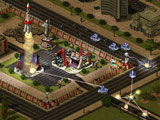 Even the game’s graphics are campy
throwbacks. While they look splendid, they clearly take their graphic style from the early
C&C and Red Alert rather than from Tiberian Sun. The broader, more cartoony style of
the original games works much better with the game’s setting and narrative than the
more “realistic” dynamically-lit graphics of TS. Even though they’re
small—especially at higher resolutions--units are nicely modeled and animated, and
again, they’re often just silly—for instance, you’ll run into the Kirov
Airship (a blimp) and trained giant squids and attack dolphins. That’s right. The
game is also full of nice little graphic effects for things like explosions, nuclear
attacks, and irradiation. But the real stars of the show are the maps, which often allow
you to fight over iconic American and European landmarks. If you fight in New York, you
can be sure that the Statue of Liberty will show up; in D.C., you’ll fight for
possession of the White House, the Washington Monument, and the Reflecting Pool; in
Chicago, you’ll establish your beachhead in Grant Park—even the Alamo makes an
appearance. While none of these maps are utterly realistic (and who’d want that
anyway), they all add to the broad, goofy tone of the game. Even the game’s graphics are campy
throwbacks. While they look splendid, they clearly take their graphic style from the early
C&C and Red Alert rather than from Tiberian Sun. The broader, more cartoony style of
the original games works much better with the game’s setting and narrative than the
more “realistic” dynamically-lit graphics of TS. Even though they’re
small—especially at higher resolutions--units are nicely modeled and animated, and
again, they’re often just silly—for instance, you’ll run into the Kirov
Airship (a blimp) and trained giant squids and attack dolphins. That’s right. The
game is also full of nice little graphic effects for things like explosions, nuclear
attacks, and irradiation. But the real stars of the show are the maps, which often allow
you to fight over iconic American and European landmarks. If you fight in New York, you
can be sure that the Statue of Liberty will show up; in D.C., you’ll fight for
possession of the White House, the Washington Monument, and the Reflecting Pool; in
Chicago, you’ll establish your beachhead in Grant Park—even the Alamo makes an
appearance. While none of these maps are utterly realistic (and who’d want that
anyway), they all add to the broad, goofy tone of the game.
In the campaign game, your missions
will build into a narrative that’s propelled by the FMVs that pop up between them.
Again, these scenes are outrageous, with lots of scenery-chewing done by the actors and
actresses. And these are good actors and actresses; you’ll vaguely recognize
them from TV and the movies. What’s more, none of them seem to be sleep-walking
through their roles; it appears they’re having a really good time hamming it up. As
in the original, you’ll be able to play as either the Allies or the Soviets, and both
of the campaigns are good fun. Missions are clever but not too difficult for experienced
players, and the campaigns serve as good extended tutorials for beginners.
But the meat-and-potatoes of any RTS
is how well its multiplayer works, and here Red Alert 2 delivers in spades. Games are
plentiful on Westwood Online’s server, and you can choose to play one of several
nationalities. Each of them has a unique and powerful special unit—for example, the
Americans have paratroopers, the Brits have snipers, the Cubans have terrorists.
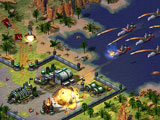 One of the big complaints about Red Alert was
of course that multiplayer gameplay often devolved into tank rushes; whoever built the
most the fastest could usually swarm an opponent with overpowered armor. Games quickly
became clickfests, without much strategy involved. While
Westwood tried to tone this down in Tiberian Sun, it didn’t really work out; a few
units (or combinations of units) were vastly overpowered, and savvy players soon sussed
out strategies which allowed them to win fairly quickly—it was like the RA tank rush,
only a little more subtle. In Red Alert 2, it seems that play balance issues have been
addressed by making almost all the units extremely powerful. One of the big complaints about Red Alert was
of course that multiplayer gameplay often devolved into tank rushes; whoever built the
most the fastest could usually swarm an opponent with overpowered armor. Games quickly
became clickfests, without much strategy involved. While
Westwood tried to tone this down in Tiberian Sun, it didn’t really work out; a few
units (or combinations of units) were vastly overpowered, and savvy players soon sussed
out strategies which allowed them to win fairly quickly—it was like the RA tank rush,
only a little more subtle. In Red Alert 2, it seems that play balance issues have been
addressed by making almost all the units extremely powerful.
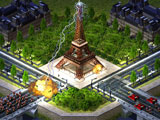 From prism tanks to Navy Seals to Chrono
Legionaires to Terror Drones to Kirov Airships, almost every unit on the board is a force
to be reckoned with. As if this weren’t enough, there are a couple of Weapons of Mass
Destruction (the Soviet Nuclear Missile and the Allied Weather Machine) that will take out
an enemy base in a heartbeat. This makes for fast, vicious games that don’t really
reward a sit-back-and-build strategy. Sure, some defensive structures will give you an
edge, but nothing’s impregnable; again, it’s like the Westwood team took the
gameplay of Red Alert, and rather than attempting to turn it down (as in Tiberian Sun)
they just amped it up to the realm of parody. Strangely enough, this ends up being an
excellent solution to the franchise's chronic gameplay problems. Multiplayer games of Red
Alert 2 are typically short and frantic and--because so many units are powerful and thus
so many strategies available—utterly unpredictable. Westwood has also made resource
gatherers much less vulnerable. The allied version is equipped with a chrono mechanism
that allows it to teleport back to base when it has a load, and the Soviet version is
heavily armed and armored. Given the increased speed of the game, the tried-and-true
strategy of picking off the enemy’s peons is now pretty risky. From prism tanks to Navy Seals to Chrono
Legionaires to Terror Drones to Kirov Airships, almost every unit on the board is a force
to be reckoned with. As if this weren’t enough, there are a couple of Weapons of Mass
Destruction (the Soviet Nuclear Missile and the Allied Weather Machine) that will take out
an enemy base in a heartbeat. This makes for fast, vicious games that don’t really
reward a sit-back-and-build strategy. Sure, some defensive structures will give you an
edge, but nothing’s impregnable; again, it’s like the Westwood team took the
gameplay of Red Alert, and rather than attempting to turn it down (as in Tiberian Sun)
they just amped it up to the realm of parody. Strangely enough, this ends up being an
excellent solution to the franchise's chronic gameplay problems. Multiplayer games of Red
Alert 2 are typically short and frantic and--because so many units are powerful and thus
so many strategies available—utterly unpredictable. Westwood has also made resource
gatherers much less vulnerable. The allied version is equipped with a chrono mechanism
that allows it to teleport back to base when it has a load, and the Soviet version is
heavily armed and armored. Given the increased speed of the game, the tried-and-true
strategy of picking off the enemy’s peons is now pretty risky.
Westwood has also made improvements
to Red Alert 2’s interface. Though it mostly retains the tried-and-true C&C
screen, you can now build defensive structures and base buildings at the same time, so
there’s no delay on that Tech Center while you’re building pill boxes. And for
those not familiar with the game’s hotkeys, a task bar has been added to the bottom
of the game screen as well.
I looked Red Alert 2 over at last
year’s E3, and was cautiously optimistic about its chances. I liked the retro/campy
setting, but I wasn’t sure about how it would play.
Well, it plays stoopid, and I mean that in the best possible way. The
game’s not for turn-based strategy guys at all—but for hardcore RTS fans it
doesn’t get much faster—or much more fun—than this.
--Rick
Fehrenbacher |
